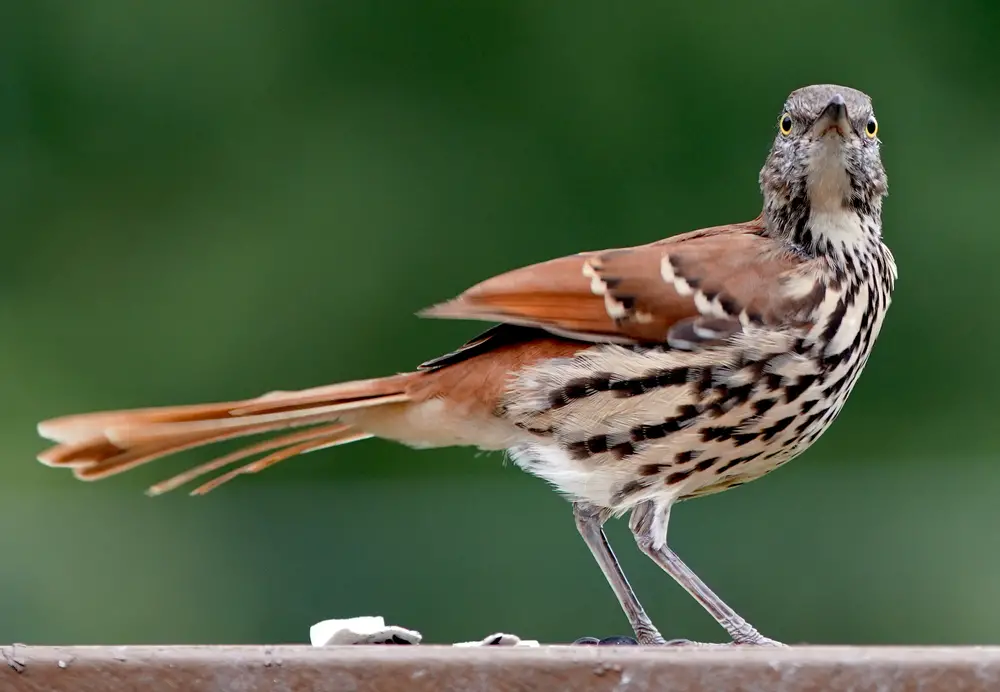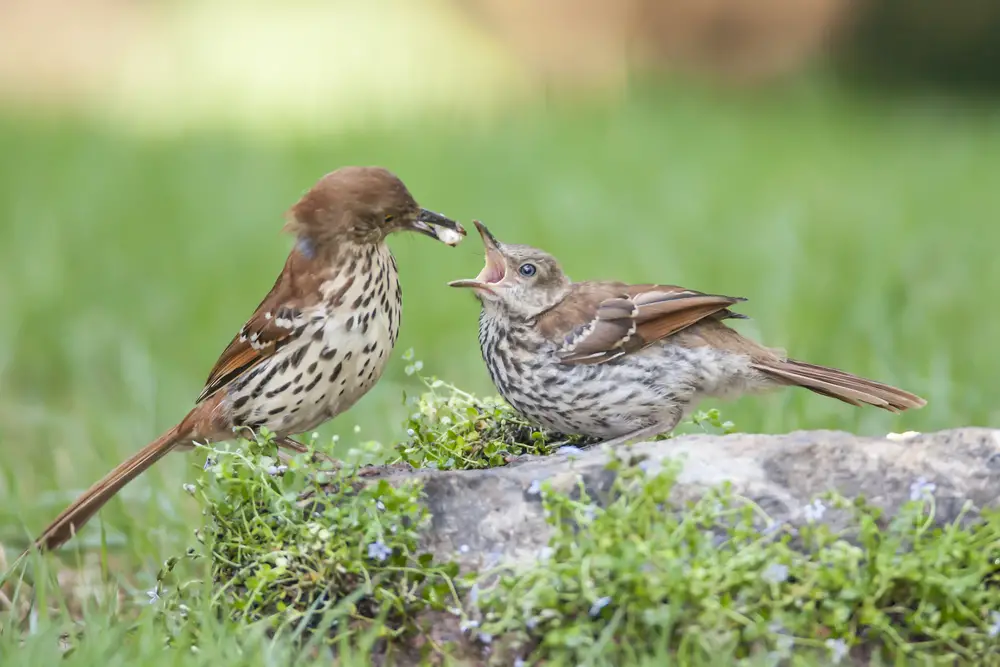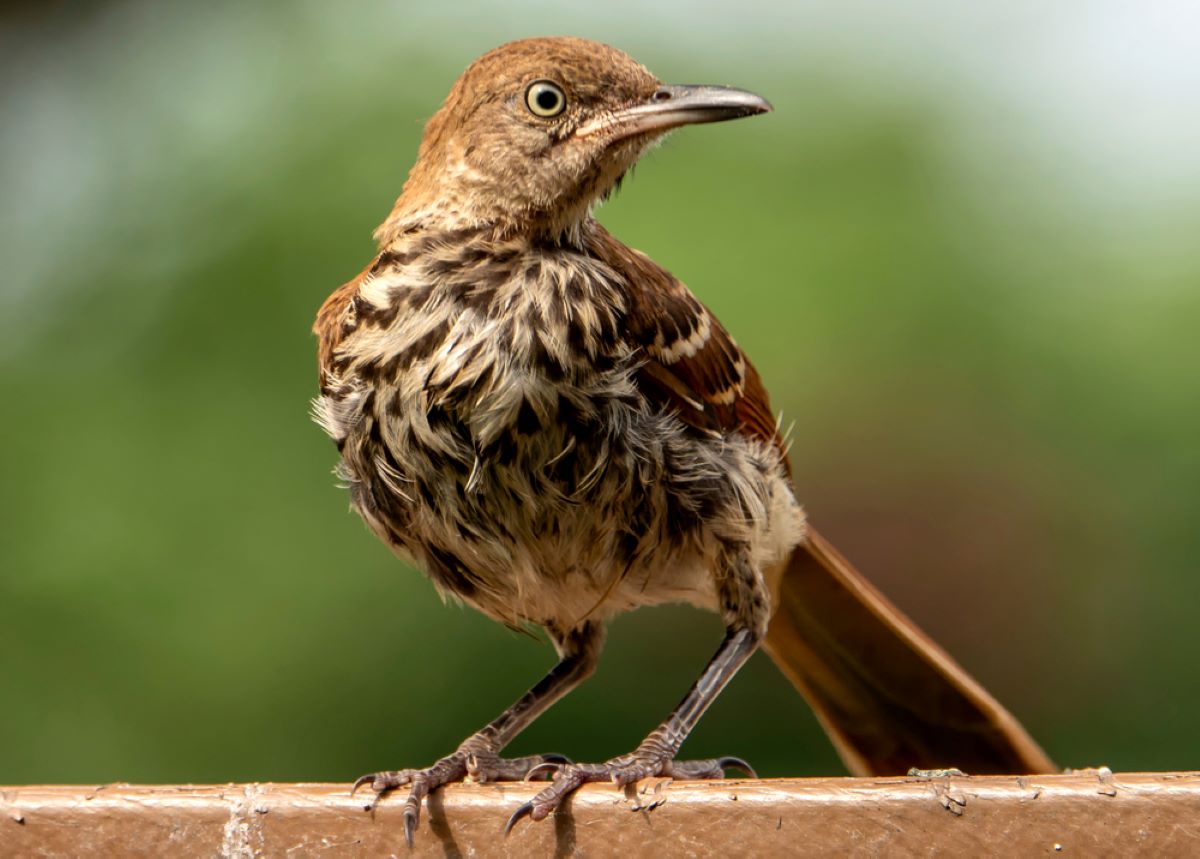Brown thrasher songs may consist of up to 3,000 different sounds, depending on the situation. Their songs serve as calls, warnings, or courtship displays. Brown thrashers are also excellent mimics, and their voice may also sound like tufted titmice or northern cardinal.
Luckily, North America is a regular territory of these birds, so you may often enjoy their company. However, a brown thrasher is not afraid to attack people, so make sure to leave its nest alone. Read on to learn more about the state bird of Georgia.
What Does a Brown Thrasher Bird Song Sound Like?
According to some sources about birds, many adult males have up to 3,000 individual songs. The male’s voice contains a somewhat more melodic tone than the one of the grey catbird. Brown thrasher songs are coherent, repeated no more than 3 times, but may last for up to a minute.
Their songs also change by the season. During the fall, males will sound smoother, while in winter, they’ll sing in short sprouts. Usually, you’ll recognize a male by a loud, long series of double phrases. Their calls sound like a smacking kiss, but may also be slurred, soft chirps, or hissing sounds.
Do Brown Thrashers Sing?
Brown thrashers have an array of bird sounds they produce in various situations. For example, both sexes have an alarm call that sounds like smacking and “teeooo.” During dusk and dawn, thrashers will make the “hijjj” sound.
Other calls include:
- “Chakk”
- “Rrrrr”
- “Tcheh”
These birds are also known for their expert mimicry, yet they can’t produce as many sounds as northern mockingbird can. During the breeding season, males will conduct a courtship display and impersonate various sounds from other birds, such as:
- Tufted titmice
- Northern cardinals
- Wood thrushes
- Northern flickers

What Is the Purpose of the Brown Thrasher Bird Song?
Brown thrashers can come up with more than 1,000 song types, where every note is repeated in 2 or 3 phrases. These different songs and imitations serve for calls or courtship displays. Additionally, any experienced birder will tell you that some brown thrasher singing means warning.
These birds aren’t afraid of attacking humans or other predators, especially when they’re close to their nests. Besides thinking of their songs, brown thrashers also imitate many other similar species.
The Brown Thrasher (Toxostoma Rufum): The Overview
The brown thrasher, also called the brown thrush and fox-colored thrush, belongs to the Mimidae family. This family also includes some other songbirds, like gray catbirds and mockingbirds. The brown thrasher is a year-round visitor around eastern and central US and southern and central Canada. This is one of the North American birds that live east of the Rockies and central Texas.
Being a member of the genus Toxostoma, this bird is on the larger side. Adults are about 9.3 to 12.0 inches with a wingspan of 11 to 13 inches. It’s close to a curve-billed thrasher and a long-billed thrasher. These two have about 10 to 12 inches in length and wingspan of about 14 inches.
When it comes to colors, the brown thrasher has reddish-brown upper parts with white underparts and dark streaks. This is why people often actually confuse it with wood thrush. Its rufous tail has rounded feathers with pale corners. Brown thrashers have yellow eyes and brown bills. Males and females have similar appearances, and juveniles aren’t that different from adults, besides the upper part markings.
Brown Thrasher Diet and Breeding
The brown thrasher eats fruits and acorns. It forages around woodland edges and likes dense shrubby vegetation in hedgerows and thickets. This bird also eats insects and will search for food around leaves. This is why some call it leaf litter. Brown thrashers will usually defend their territory and even attack people in some cases.
These birds come either alone or with a partner, but they’re typically monogamous. Their breeding season is different based on the region. Brown thrashers located in the southeastern US breed during February and March. Those that live in the northern areas mate during May and June.
These birds breed in dense, low-growth, mixed woods, edges of swamps, or open pine woods. They’ll also mate in suburban neighborhoods. Both parents take care of the young while the female manages the incubation. Youngsters will fledge about 9 to 13 days from hatching. Brown thrashers raise 2 to 3 broods annually.

Get Brown Thrashers in Your Yard
If you want to devote some time to bird watching and live in the area where brown thrashers are common, set up seeds and nuts ground feeders around. Plant berry-producing shrubs that will give them additional food and shelter. Additionally, avoid using insecticide since thrashers love munching on insects.
You can also feed thrashers with suet, peanut, cracked corn, or sunflower seed. Thrashers will nest in low vegetation, so don’t take low-growing trees away. Don’t forget to include a bird bath as a water source, and you’ll have some thrashers in your yard in no time.

